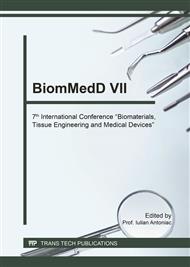p.81
p.87
p.93
p.99
p.105
p.111
p.119
p.126
p.132
Titanium Mesh Implants - Alternative for Cranial Bone Defects
Abstract:
Calvarial bone defects are due to cranial bone removal at the end of the surgery (decompressive craniectomy), either because of bone involvement of the tumor or as a method to relieve intracranial pressure caused by important cerebral edema secondary to large tumors or traumas. With the progress of biomedical technology, new materials are available for use by surgeons. The titanium mesh implant is a plating platform with a matrix design and MRI compatibility that can be easily shaped, cut, and bent by the surgeon according to the bone defect. It is locked in place by several screws tapped into the bone. Although may different type of materials are currently available there is no consensus for the best method to be used. The aim of this study was to report our experience with titanium mesh implants for cranial repair and reconstruction of bone anatomy.Twenty four patients with decompressive craniectomies that required reconstruction of the calvarial bone defect for which a titanium mesh cranioplasty was used, operated in our Neurosurgery Department between January 2013 and April 2016 where included in this retrospective study. Of the 24 patients, only one had a localized infection complication for which the patient was re-operated and the implant removed with no other complications. No other neurological, infectious and functional complications were observed during or after surgery. All other patients had excellent anatomic and functional results with a positive feedback for the aesthetic aspects of the implant. The use of these bio-compatible materials is a viable, safe and reliable solution for the management of cranial bone defects offering the surgeon a large array of options for the benefit of the patient. It has a proven cost-effectiveness when compared to other customized prosthetics with the same outcomes. The MRI compatibility was proven very useful, especially for neoplasm patients who required frequent cranial imaging follow-ups, and reduced operating time was particularly beneficial to elderly patients.
Info:
Periodical:
Pages:
105-110
Citation:
Online since:
August 2017
Keywords:
Price:
Сopyright:
© 2017 Trans Tech Publications Ltd. All Rights Reserved
Share:
Citation:


